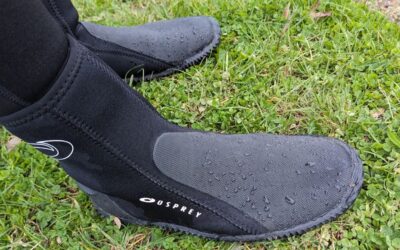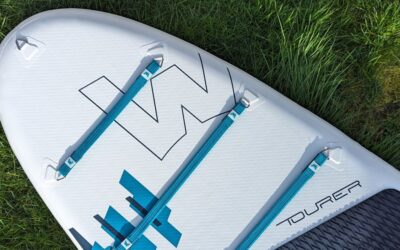Welcome back to the second part of our series on mastering the art of paddleboarding.
In part one of our paddleboarding 101 series, we introduced you to this fantastic watersport, a perfect blend of surfing and kayaking that promises thrilling experiences. Now, we dive deeper into the journey.
In this comprehensive guide, we’ll explore three essential aspects that form the backbone of a rewarding paddleboarding experience and learn how to stand up on a paddle board. Let’s briefly delve into what we’ll be covering:
How to Launch Your SUP: The launching process is crucial to your paddle boarding journey. It involves the proper placement and handling of your paddle board in the water. We’ll discuss the best practices to launch your stand up paddle board, from choosing the perfect location to carrying your board to the water, to stepping onto the board with confidence.
How to Stand Up on Your SUP: Standing up on a paddle board is a milestone moment for every paddler. We’ll break down this process into easy-to-follow steps. By following our guide, you’ll be standing up on your paddle board and ready to paddle forward.
How to Balance on Your Paddle Board: Balance is key to enjoying paddle boarding. We’ll share tips and tricks on maintaining your balance, how to position your body, where to keep your feet, and the importance of core muscles. You’ll learn how to stay balanced on your stand up paddle board, even in slightly challenging water conditions.
How to Launch Your Paddle Board: A Step-By-Step Guide

Launching a stand up paddle board is the first significant step into the exhilarating world of paddle boarding. It might seem daunting, but with a little practice and the right knowledge, you can easily master this skill. So, let’s take a deep dive into the process:
Step #1 Choose the Perfect Location
Your choice of location greatly influences your launching process. Look for a calm and shallow swimming area with knee-deep water. If you’re starting on an inflatable paddle board, ensure there’s a large flat area for inflation. Avoid locations with strong currents or wave action, especially for your first SUP outing.
Step #2 Prepare Your Paddle Board
Before heading into the water, ensure that your paddle board is ready. If you’re using inflatable SUPs, also known as iSUPs, inflate them until they’re firm to the touch. For EPS foam core paddle boards or those with a carbon fibre construction, check the board’s integrity. Secure any gear, attach the leash tethers, and ensure your personal flotation device (PFD) and safety whistle are close at hand. The carry handle should be in the centre point of the board, which is the balance point.
Step #3 Carry Your Paddle Board to the Water
Using the carry handle, lift your paddle board. Remember to bend from your knees, not your back, to prevent strain. If the board is large or heavy, you may need to carry it overhead. Always keep the board’s pointed nose forward and the fins in the back.
Step #4 Place the Paddle Board in the Water
Once you reach the water, gently place your board in the water with the fins down, and the deck up. Ensure the water is knee-deep, so the fins don’t touch the bottom.
Step #5 Get Onto Your Paddle Board
The easiest method to mount your paddle board is the kneeling method. Start by laying your sup paddle horizontally on the board, just ahead of the carry handle. Now, position one knee on the stand up paddle board, then the other, settling yourself into a kneeling position around the board’s middle. If you’re still unsure, feel free to start by lying prone on the board and using your hands to paddle out, much like a surfer. As you gain more confidence, transition to a kneeling or standing position.
Step #6 Start Paddling
Pick up your SUP paddle, ensuring the blade forward and T grip are properly held. Start paddling gently, alternating paddle strokes on each side to move in a reasonably straight line.
Launching a paddle board is pretty straightforward forward and I’m sure you’ll master it in no time but remember, everyone learns at their own pace, so don’t rush yourself. The goal is to have fun while learning and exploring the world of paddleboarding.
Up next, we’ll discuss how to stand up on a paddle board.
How to Stand Up on a Paddle Board

Standing up on your SUP, A.K.A stand up paddleboard is a significant milestone for every paddler. Although it might seem challenging at first, it’s a skill that you can easily master with a little bit of practice and the correct techniques.
Here, we’ll break down this process into a series of easy-to-follow steps:
Step #1 Start in a Kneeling Position
Begin your journey to standing by first being on your knees. Ensure you’re positioned around the centre of the board, where the carry handle is located. This central location is usually the board’s balance point, which will help keep the board stable as you move. Keep your knees slightly bent and hip-width apart, mirroring the position your feet will be in when you stand up.
Step #2 Grab Your SUP Paddle
Hold your paddle with both hands while still kneeling. Remember, your paddle grip should be firm but not too tight. The T grip should be held by one hand, with the other on the paddle shaft. Both arms should be relatively straight.
Step #3 Prepare to Stand
Before you fully stand, move into a crouching position. This means lifting your body up so that your weight is on your feet, which should still be positioned where your knees were. This gives you a lower centre of gravity and helps with balance as you prepare to stand.
Step #4 Stand Up
Slowly stand up, one foot at a time. Keep your feet parallel and hip-width apart, toes pointing forward. Your knees should remain slightly bent to help maintain balance. Try not to look down; instead, look straight ahead. Your head is a heavy part of your body, and where you look, your weight tends to follow, which can help or hinder your balance.
Proper Foot Placement on Your SUP
Positioning your feet correctly on your SUP board is crucial for maintaining balance, controlling the board, and manoeuvring effectively while paddle boarding. Let’s break down these positioning aspects:
Position Yourself Centre Board: If you’re just starting out, aim to stand near the middle of the board. The carry handle, usually located at this central point, serves as a handy marker.
Hip-Width Apart: Stand with your feet approximately hip-width apart, straddling the handle on either side. This stance provides a stable base, allowing your body to maintain balance more easily.
Parallel To Each Other: Your feet should be parallel to each other, not angled outwards or inwards. This provides better balance and control over the paddle board.
One Foot Forward When Turning: When performing turns, it might be helpful to put one foot slightly forward. This will shift your weight and help the board to turn more effectively.
Step #5 Balance Yourself
Once standing, it’s important to stay relaxed and maintain your balance. This can be achieved by keeping your knees slightly bent, feet parallel, and spreading your weight evenly across both feet. Also, remember to engage your core muscles, which are vital for maintaining balance on a paddle board.
Congratulations, you’re now standing on your paddle board! With practice, standing up on your paddle board will become second nature. Don’t be disheartened if you fall a few times during your initial attempts. Even the most experienced paddlers fall in the water now and then. What’s important is that you get back up on your board and keep trying.
Next, we’ll tackle the third part of our guide, which covers how to balance on your paddle board. Let’s keep paddling forward on our SUP journey!
Maintaining Balance on Your Paddle Board

The ability to maintain balance is a cornerstone skill in paddleboarding. A shaky stance can cause unplanned swimming sessions and affect your overall stand up paddle boarding experience.
In this section, we’ll share some practical tips and techniques on how to stay balanced on your paddle board, even when facing slightly challenging water conditions.
Understanding Your Paddle Board
Understanding your paddle board is the first step to maintaining balance. Paddle boards come in different shapes and sizes, each designed for specific activities and water conditions. Wider paddle boards generally offer more stability and are great for beginners, while narrower paddle boards are designed for speed and agility, ideal for more experienced riders.
Body Positioning
Good body posture is essential for maintaining balance. Stand upright with your back straight, knees slightly bent, and feet hip-width apart. A slightly bent stance gives your body the flexibility to adjust and react to the movement of the board and the water.
Feet Positioning
Keeping your feet properly positioned can significantly affect your balance. Your feet should be placed parallel to each other and about hip-width apart on either side of the board’s centre, typically marked by the carry handle. This stance provides a stable base for you to balance on the board.
Engage Your Core
Paddleboarding is a full-body workout, but your core muscles play a crucial role in maintaining balance. When you’re standing on the board, engage your core muscles. It will help you remain stable, especially when the water gets a bit choppy.
Keep Your Eyes on the Horizon
Another crucial balance tip is to keep your eyes on the horizon rather than looking down at your feet. Looking forward helps keep your body in the correct upright position and makes it easier to anticipate changes in the water.
Start in Calm Waters
Starting in calm waters is a good idea when you’re still mastering your balance. As you gain confidence and improve your skills, you can slowly start paddleboarding in more challenging conditions.
Practice Makes Perfect
Lastly, but most importantly, practice. Paddleboarding is like riding a bicycle, the more you do it, the better you become at maintaining balance. Don’t be discouraged by a few falls; they’re part of the learning process.
In conclusion, achieving balance on your sup board largely boils down to understanding your board, proper body posture and feet positioning, engaging your core muscles, and consistent practice. As you spend more time on the water, you’ll find your balance improving. So, keep at it and enjoy your time on the water!

Final Thoughts
Paddleboarding is more than just a watersport; it’s a journey. From the moment you launch your board onto the water to the moment you’re standing up and maintaining balance on your SUP, each step is a progression in your paddleboarding experience. With the tips provided in this guide, you’ll have a strong foundation to navigate this journey with confidence.
Remember, each paddle boarder was once a beginner. The key is to be patient with yourself and practice consistently. Everyone learns at their own pace, so don’t be disheartened if you fall a few times. It’s all part of the process, and with each fall, you’re one step closer to mastering this fantastic sport.
As we conclude this part of the series, I hope you feel more equipped to launch, stand up, and balance on your paddle board. But the journey doesn’t end here. The next part of the series will teach you how to paddle your paddle board efficiently and effectively.
How to Stand Up on a Paddle Board FAQ
Is it hard to stand up on a paddle board?
Not necessarily. Like any new skill, standing up on a sup board requires a bit of practice. Initially, you might find it challenging, but with a few tries, the right techniques, and balance, you’ll be up and standing in no time.
Do you wear shoes while stand up paddle boarding?
Typically, paddleboarding is done barefoot to maintain a better grip and balance on the board. However, water shoes or neoprene boots can be worn in colder conditions or rocky entries to protect your feet.
Will I get wet paddleboarding?
While it’s possible to stay dry, especially in calm water conditions, it’s quite likely you’ll get a bit wet from splashes, paddle drips or even from falling into the water – which is part of the fun! Always wear suitable attire for getting wet.
Can you sit down to paddle board?
Absolutely! In fact, many beginners start by sitting or kneeling on their paddle boards. As you gain more confidence and balance, you can transition to standing up.
Should you lock your knees when paddleboarding?
No, it’s best to keep your knees slightly bent when paddleboarding. This stance improves your balance, makes it easier to absorb the motion of the waves and reduces the strain on your joints.
Do you have to be physically fit to paddle board?
While being physically fit can help, it’s not a strict requirement for paddleboarding. The sport is about balance and technique as much as it is about physical strength. Moreover, paddleboarding itself is a great way to improve fitness levels!
Why am I so wobbly on a paddleboard?
Wobbling or instability on a paddleboard often stems from nervousness, poor stance, or standing on the wrong part of the board. Ensure your feet are hip-width apart around the centre point of the board, your knees are slightly bent, and you maintain a relaxed and focused attitude. With practice, you’ll soon feel less wobbly and more comfortable.

About the Author
Steve Cleverdon is an adventure blogger dedicated to helping outdoor enthusiasts make the most of their outdoor experiences. With years of travel and many epic adventures including a 3000-kilometre solo hike across New Zealand, Steve has amassed practical knowledge on outdoor gear. You can learn more about his adventures here. Through expert reviews, recommendations, and guides, he equips his readers with the best gear for their next adventure. If you want to send Steve a quick message, visit his contact page here.




